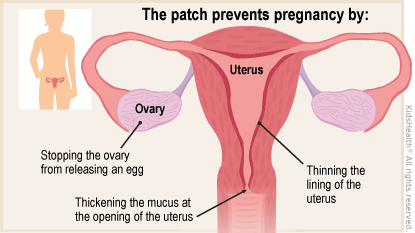The Birth Control Patch
The birth control patch contains hormones that prevent pregnancy. When used correctly, it is a reliable form of birth control.


-
It's important to use a condom every time you have sex (vaginal, oral, or anal), even when you're on the patch, because:
-
Depending on where you were in your period cycle when you start the patch, it might not work as birth control right away.
-
Condoms protect you from sexually transmitted diseases (STDs, also called STIs or sexually transmitted infections).
-
Using condoms while on the patch makes it even less likely that you will get pregnant.
-
Don't smoke. Smoking puts you at risk for serious side effects from the patch and many other medical conditions. If you need help quitting, go to teen.smokefree.gov or call 800-QUIT-NOW (800-784-8669).
-
Wear the patch for 3 weeks, and then leave it off for 1 week. Here's how:
-
Put the patch on your skin on the day that your health care provider told you to.
-
Change the patch every week on the same day so that you wear the patch for 3 weeks. For example, you will change your patch on Mondays if that's the day you put the patch on. Set a reminder on your phone or write a reminder on a calendar to help you remember when to change your patch.
-
Take the patch off your skin for the 4th week. Your period should start during that week.
-
To place the patch:
-
Follow the instructions included with your prescription on how to put your patch on.
-
Put the patch on your stomach, back, butt, or upper arm. Don't put it on your breasts.
-
Change where you put the patch every week.
-
Do not take the patch off for swimming or bathing.
-
Do not put the patch over makeup, creams, lotions, or powders.
If you forgot to put a new patch on, if you forgot to change the patch, or if the patch falls off early, read the instructions that came with the patch or call your health care provider. You may need a backup method of birth control.

-
You forgot to put a new patch on or change the patch, or if the patch falls off early.
-
The patch irritates your skin.
-
You have cramping, spotting, or irregular bleeding that continues longer than 6 weeks after starting on the patch.
-
You have heavy bleeding (soaking through a pad or tampon every hour for more than 2 hours).
-
Your mood is affected by the birth control patch.
-
You have signs of an STD (such as belly pain, fever, abnormal discharge, pain when peeing or having sex, or genital warts or sores), or if you had sex without a condom and are worried you could have an STD.
-
You start any new medicines, including antibiotics and herbal or natural medicines. Some can make the patch not work.
-
Your weight goes above 198 pounds (90kg). The patch may not work to prevent pregnancy above this weight.
-
Your skin or eyes look yellow, which can be signs of liver problems (a very rare side effect of the birth control patch).

You have lower leg pain, chest pain, trouble breathing, weakness, tingling, trouble speaking, or vision problems. These can be signs of a blood clot, which is an extremely rare side effect from the hormones in the birth control patch.

How does the patch prevent pregnancy? The patch:
-
prevents the release of an egg during the monthly menstrual cycle
-
makes it harder for a fertilized egg to grow in the uterus
-
thickens the cervical mucus, which makes it harder for sperm to reach an egg
What are the side effects of the patch? The most common side effects are:
-
irregular or no periods
-
cramping during periods
-
skin irritation where the patch was placed
-
nausea, headaches, dizziness, or breast tenderness
-
mood changes such as nervousness or sadness
What if I have sex before the patch is working and I don't use a condom or it breaks? Emergency contraceptive ("morning after") pills are available at the pharmacy without a prescription or ID. They delay ovulation (the release of an egg). This way there is no egg for the sperm to fertilize. If the egg was already fertilized and implanted in the uterus wall, emergency contraceptive pills will not stop the pregnancy.